¿Es segura y eficaz la hospitalización a domicilio de los pacientes agudos que ingresan por infección?
IF 1.7
4区 医学
Q2 MEDICINE, GENERAL & INTERNAL
引用次数: 0
Abstract
Introduction
Home hospitalization (HH) is a safe, effective and more efficient modality of care than conventional hospitalization (CH). There is little scientific evidence comparing these two models of hospitalization in patients admitted from the Emergency Department (ED) for infection.
Material and methods
Retrospective cohort study between October 1 and December 15, 2023 of patients admitted from the ED for infection. Two cohorts were analyzed, the first one, patients admitted to CH in Internal Medicine, Geriatrics or Infectious Diseases units and the second one, patients admitted to HH. Patients with hemodynamic instability, those who died in the first 48 hours of admission, S. aureus bacteremia, catheter-associated bacteremia, osteoarticular infection, meningitis, diverticulitis, fever without focus, and infections with undrained focus were excluded.
Results
257 patients were analyzed, 151 in CH and 106 in HH. The median duration of antibiotherapy was 9 days in HC vs 7 in HH (p < 0.001), the mean length of stay was longer in CH vs HH (6 vs 4; p = 0.007). More laboratory tests were performed in CH vs HH (3 vs 1, p < 0.001), radiographs (11% vs 0%), ultrasound (12% vs 2%) and computed axial tomography (13% vs 3%, p < 0.001). Patients admitted to CH had more confusional syndrome than those admitted to HH (15% vs 2%; p < 0.001). There were no differences in mortality or readmissions. In the multivariate linear regression analysis, patients admitted to HH shortened their hospital stay by 1 day (95% CI: -2.2– -0.185) compared to those admitted to CH.
Conclusion
Patients admitted for infection in HH from the ED have a shorter hospital stay than patients admitted to CH.
急性感染住院患者在家住院是否安全有效?
家庭住院(HH)是一种比传统住院(CH)更安全、有效和高效的护理方式。很少有科学证据比较这两种住院模式的患者从急诊科(ED)入院感染。材料与方法回顾性队列研究于2023年10月1日至12月15日在急诊科因感染入院的患者。对两个队列进行分析,第一个队列是在内科、老年科或传染病科住院的CH患者,第二个队列是在HH住院的患者。排除有血流动力学不稳定、入院前48小时内死亡、金黄色葡萄球菌菌血症、导管相关性菌血症、骨关节感染、脑膜炎、憩室炎、无病灶发热和病灶不排水感染的患者。结果共分析257例患者,其中CH 151例,HH 106例。抗生素治疗的中位持续时间HC为9天,HH为7天(p <;0.001), CH组比HH组的平均住院时间更长(6 vs 4;p = 0.007)。在CH和HH中进行了更多的实验室测试(3 vs 1, p <;0.001), x线片(11% vs 0%),超声(12% vs 2%)和计算机轴位断层扫描(13% vs 3%), p <;0.001)。入院的CH患者比入院的HH患者有更多的混淆综合征(15% vs 2%;p & lt;0.001)。死亡率和再入院率没有差异。在多元线性回归分析中,HH患者的住院时间比CH患者缩短了1天(95% CI: -2.2 - -0.185)。结论急诊HH感染患者的住院时间比CH患者短。
本文章由计算机程序翻译,如有差异,请以英文原文为准。
求助全文
约1分钟内获得全文
求助全文
来源期刊

Revista clinica espanola
医学-医学:内科
CiteScore
4.40
自引率
6.90%
发文量
73
审稿时长
28 days
期刊介绍:
Revista Clínica Española published its first issue in 1940 and is the body of expression of the Spanish Society of Internal Medicine (SEMI).
The journal fully endorses the goals of updating knowledge and facilitating the acquisition of key developments in internal medicine applied to clinical practice. Revista Clínica Española is subject to a thorough double blind review of the received articles written in Spanish or English. Nine issues are published each year, including mostly originals, reviews and consensus documents.
 求助内容:
求助内容: 应助结果提醒方式:
应助结果提醒方式:


